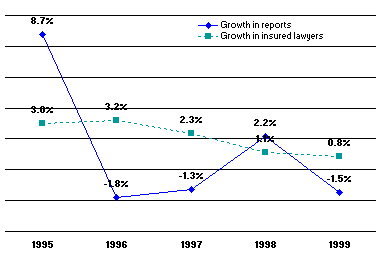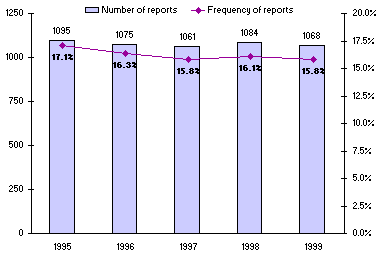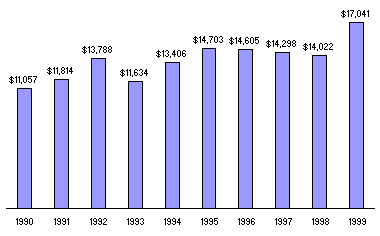This Insurance Issues touches on various aspects of both the liability insurance program and the compulsory insurance policy. Commentary on the policy includes details of minor changes in the 2001 policy wording and discussion of the insurance implications of the Western Law Societies Conveyancing Protocol, as outlined in the January-February Benchers' Bulletin enclosed in this mailing.
Stability, stability, stability
Current experience shows that the program remains very stable.
The chart Percentage growth in reports and insured lawyers (see page 3) shows the percentage growth over the past five years. Insured lawyers include both full and part-time lawyers, and reports include both claims and potential claims (or incidents).
Percentage growth in reports and insured lawyers

The chart Number and frequency of reports shows the number and frequency of reports (the number of reports divided by the number of insured lawyers) over the past five years.
Number and frequency of reports

The chart Average Cost of Claims shows the average cost per report over the last 10 years, based on our actuary’s estimate of expected losses.
Average cost of claims

These charts illustrate that the number of reports and the growth in the number of insured lawyers remain consistent, as does the average cost of claims. The negligible change in the annual number of reports reflects an equally negligible change in the annual growth rate of lawyers (0.5%). The slight upward trend in the average cost of claims over the 10-year period indicates that significant adverse developments are unlikely. Although 1999 reveals an increase in the severity (average cost) of reports, actuarial estimates tend to fall as time passes, and claim costs for 1999 are expected to come more in line with preceding years.
Assessment
The Benchers set the annual insurance assessment at $1,500 in 2001, maintaining for a second consecutive year the lowest premium in the program’s history. The base assessment has been reduced incrementally since 1996, due largely to the Insurance Fund surplus. The current level of assessment is expected to reduce the surplus and may not be sustainable in the long term.
Policy wording
A consolidated policy was issued in 2000, incorporating changes to the wording over the previous two years, along with some further revisions. The policy wording for 2001 is altered slightly by an endorsement to the consolidated policy, a copy of which is enclosed in this mailing. Both the 2001 endorsement and the 2000 consolidated policy are also available in the Resource Library of the Law Society’s website (www.lawsociety.bc.ca). This year brings only a few minor changes to the policy language, as follows:
- The words "and in a supporting role to" are added to the definition of "Additional Insured" (d). These words clarify that only those employees acting in a supporting role to the Individual Insured, as well as under the Individual Insured’s supervision and within the scope of their duties, are included as Additional Insureds under the policy.
- The definition of "damages" has two amendments. The first amendment ensures that claims for pre- judgment interest, post-judgment interest and costs are covered only if sought pursuant to a monetary award or settlement that is covered by the policy. The second amendment now specifies the exclusion of any order made pursuant to Rule 57(37) of the Supreme Court Rules.
- Exclusion 6.2.3 is revised by replacing "the Individual Insured’s law firm, law firm’s partners or law firm’s associates" with "the partners or associates of the Individual Insured or of the Individual Insured’s law firm". This simply clarifies that 6.2.3 of the Exclusion extends to all partners and associates of an Individual Insured or of the Individual Insured’s firm.
- The words "as a member of that other law society or bar" are removed from Exclusion 8, clarifying that coverage is excluded if a lawyer is practising permanently in another jurisdiction and is also a member of that other jurisdiction’s law society or bar.
Coverage
Limits of coverage remain unchanged. Each insured lawyer is provided with $1 million of coverage for each error, with an annual maximum of $2 million for all errors reported during the year. The deductible remains at $5,000 for each paid claim, increasing to $10,000 for each subsequent paid claim reported within three years.
Although the scope of coverage remains unchanged, the Benchers will consider in 2001 whether any changes should be made to Exclusion 6.2, the business exclusion.
Voluntary excess insurance
The limits and scope of coverage provided by the mandatory insurance program may be insufficient to protect lawyers from potential liability risks inherent in practice. Personal liability for defence costs and damages that are ultimately uninsured can be financially devastating. Exposure to such liabilities may arise from claims that exceed the limits of mandatory coverage or are not covered by the policy. The adequacy of insurance depends, in part, on the nature of a lawyer’s own activities, as well as those of partners, associates and employees and the potential impact of those activities, in a worst case scenario, on clients and third parties. Excess insurance extends the limits of coverage offered by the mandatory policy, and may pick up risks not covered by it. It is available on the private market. Lawyers should consult a broker experienced in lawyers liability insurance to determine excess insurance needs.
Western Law Societies Conveyancing Protocol
Lawyers acting for institutional lending clients on residential mortgage transactions may wish to participate in this initiative. The initiative allows lawyers, in certain circumstances, to advise a lender client that it need not obtain an up-to-date building location survey before funding a loan secured by a mortgage. If the lender suffers an actual loss as a result of an unknown building location defect that would have been disclosed by an up-to-date survey, the Lawyers Insurance Fund will, on behalf of the lawyer, accept liability and as appropriate pay the cost of repair or of any actual loss suffered. The program will waive the deductible and surcharge for the lawyer, and allow the lawyer to retain eligibility for the part-time discount, provided he or she has complied with the terms of the Protocol. For further information on this initiative, please see the Benchers’ Bulletin.
2001 and beyond
Although Y2K computer difficulties have not yet materialized in a claim against the Insurance Fund, the new millennium continues to present challenges for practising lawyers. Technological changes and innovations, now occurring at a rapid-fire rate, add an ever-increasing element of risk to practice. There also remains the potential for exposure to lawyers from existing risks such as duties to third parties, involvement in questionable financial or commercial schemes and class actions.
The most significant element in insurance costs is how each lawyer handles the inherent risks in practice, now and in the future. Care and attention to individual files and effective risk management remain the primary tools for keeping the insurance assessment at, or near, its present level.